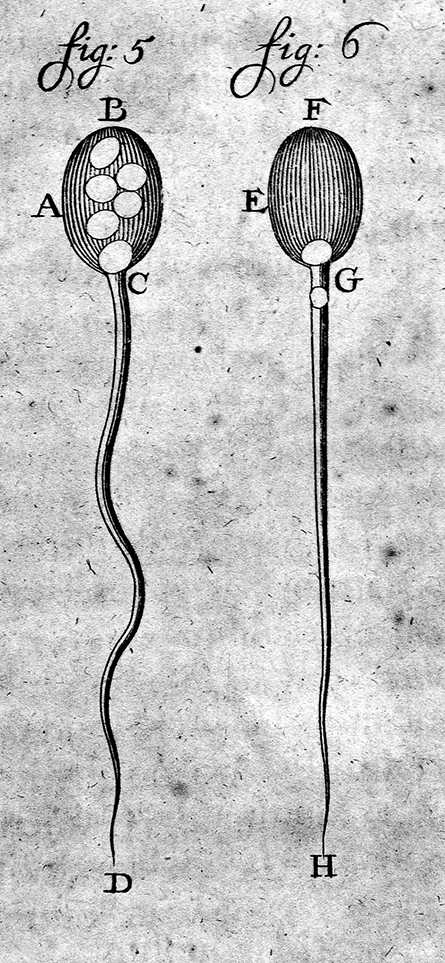The metabolic trigger that activates sperm
When viewed under a microscope, sperm cells typically look like eager swimmers with a singular purpose. But despite the haste that their flagella and behavior imply, sperm are hardly ready to go at a moment’s notice.

he detailed here in his 1719 book "Opera omnia."
After ejaculation, they need up to an hour to undergo a process of posttranslational modifications called capacitation, which alters their heads so they can merge with an egg and changes the movement patterns of their tails to a frenzied state of hyperactivity before they are able to fertilize that egg. While in this state, sperm shut off their typical metabolic pathway, oxidative phosphorylation, and instead begin to rely on glycolysis for their final push. One of the biochemical changes that makes capacitation possible is the covalent addition of sialic acid to the terminal end of glycoproteins, or sialyation, a process that only affects a handful of proteins on sperm but is essential to fertilization.
To better understand the role that sialyation plays in fertilization, researchers at the University of Newcastle used a tandem mass spectrometry and liquid chromatograph approach to examine the glycoproteomic changes in sperm cells that had been made to undergo capacitation through incubation for 90 minutes. They detailed their results in the journal Molecular & Cellular Proteomics.
“We wanted to know, if we take sperm before and after capacitation, what would change in terms of the sialic acid proteins,” said Mark Baker, a Newcastle scientist who researches the proteomics of sperm and male fertility. “And the answer was extremely little, which was quite surprising. Very, very, very few proteins, 0.4% or something stupidly small.”
But the paltry six proteins that Baker and his colleagues found had decreased sialic acid content, which he attributed to either shedding or the activity of a glycosidase, turned out to be glycolic red herrings after they noted a lone protein that had increased sialyation.
That protein’s name? Aconitase, or ACO2, an enzyme in the citric acid cycle that catalyzes the isomerization of citrate to isocitrate. Thanks to a computer model built by Vincenzo Carbone, a co-author at the Grasslands Research Centre, the researchers then found that sialyation causes a conformational change in aconitase’s alpha helix that distorts its active site and completely shuts it down, along with oxidative phosphorylation as a whole.
“We think that would suggest that when you stop oxidative phosphorylation and shuttle the metabolic pathway through to glycolysis, that’s probably a trigger for the hyperactivation, or probably helps it in some way, but we don’t know,” Baker said.
However, hyperactivity itself is not well understood. According to Baker, researchers currently have multiple competing theories about its role and purpose in fertilization.
“The only thing that we know for sure is that without hyperactivation, you just don’t get fertility.”
Enjoy reading ASBMB Today?
Become a member to receive the print edition four times a year and the digital edition monthly.
Learn moreGet the latest from ASBMB Today
Enter your email address, and we’ll send you a weekly email with recent articles, interviews and more.
Latest in Science
Science highlights or most popular articles

Mining microbes for rare earth solutions
Joseph Cotruvo, Jr., will receive the ASBMB Mildred Cohn Young Investigator Award at the ASBMB Annual Meeting, March 7–10, just outside of Washington, D.C.

Fueling healthier aging, connecting metabolism stress and time
Biochemist Melanie McReynolds investigates how metabolism and stress shape the aging process. Her research on NAD+, a molecule central to cellular energy, reveals how maintaining its balance could promote healthier, longer lives.

Mapping proteins, one side chain at a time
Roland Dunbrack Jr. will receive the ASBMB DeLano Award for Computational Biosciences at the ASBMB Annual Meeting, March 7–10, just outside of Washington, D.C.

Exploring the link between lipids and longevity
Meng Wang will present her work on metabolism and aging at the ASBMB Annual Meeting, March 7-10, just outside of Washington, D.C.

Defining a ‘crucial gatekeeper’ of lipid metabolism
George Carman receives the Herbert Tabor Research Award at the ASBMB Annual Meeting, March 7–10, just outside of Washington, D.C.

The science of staying strong
Muscles power every movement, but they also tell the story of aging itself. Scientists are uncovering how strength fades, why some species resist it and what lifestyle and molecular clues could help preserve muscle health for life.

